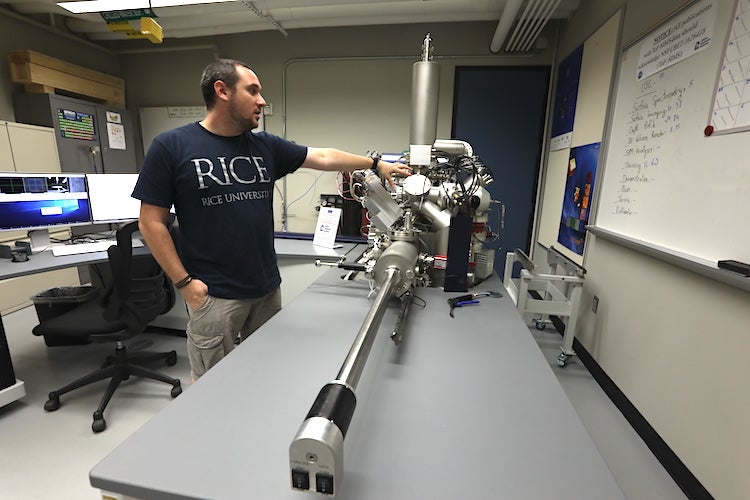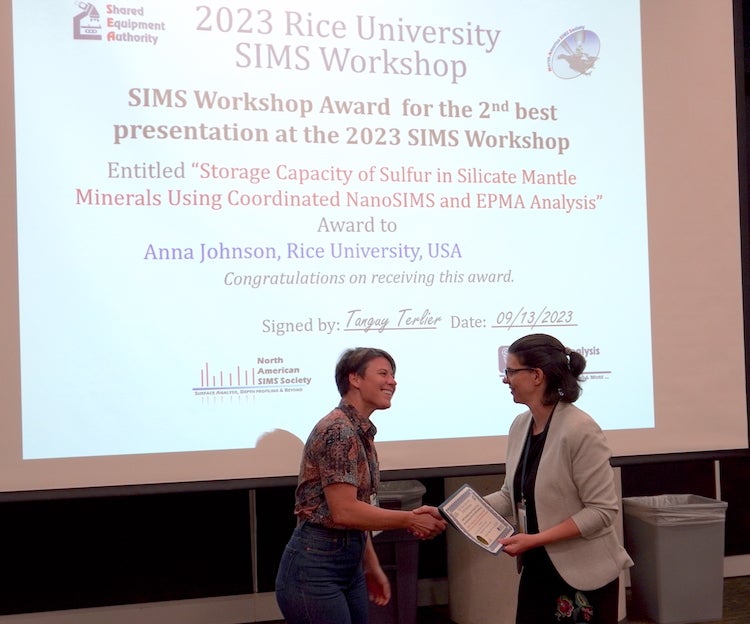
The 2023 Rice University SIMS (Secondary Ion Mass Spectrometry) Workshop, held at Rice University’s Bio Science Research Collaborative Exhibition/Event Hall on September 12-14, 2023. This meeting brought together a diverse community of scientists to exchange new ideas, create new collaborations, mentor young scientists, and provide opportunities for the community to learn fundamental and practical techniques of surface analysis and their applications.

The three-day meeting, organized by Research Specialist and ToF-SIMS instrument manager Dr. Tanguy Terlier, included invited experts from government, academia, and industry who presented on a wide range of topics, from characterizing the performance of energy materials to interpreting complex biological processes for a variety of organisms.
“The annual U.S. SIMS meeting had not met since 2015, so this event was to be a way to reinvigorate the SIMS community in North America. This year’s workshop hosted surface analysis tutorials featuring national and international experts that introduced state-of-the-art methods for our young researchers. In order to attract as many students as possible, the organization committee dedicated $5,000 for student awards.
We had 180 registrations, with 130 attendees in person and 35 virtual ones. I have appreciated the involvement and attendance from Rice students in particular considering that the Surface Analysis tutorials were a very unique opportunity for them to learn about the techniques,” says Terlier.
EEPS Ph.D. candidates Anna Johnson and Haolin Zhou attended the meeting. Both received awards for their presented research.
To avoid the stress of competing for honors at the time they were presenting, all students who registered were asked to submit a resume, a support letter from their advisor and a five minute video presenting a research abstract prior to the conference. Entries were evaluated by a committee and criteria organized by the North American SIMS society, and then winners announced during the meeting.
Haolin Zhou, who works with EEPS faculty Mark Torres, presented a poster, Estimating thermal maturity of fossil organic matter using electron microprobe during the surface analysis tutorials session. Zhou’s work identifies a novel, multi-instrument, non-destructive approach that not only preserves organic matter (OM) in samples, but takes less time and produces additional information that has applications across industry and environmental research.
The approach compares traditional destructive methods, including vitrinite and bitumen reflectance, pyrolysis and biomarker analyses, against non-destructive EPMA WDS (wave-length dispersive spectrometry) analyses of carbon peak area and position to develop a sensitive yet robust correlation from six well-known, fully characterized organic-rich shales over a range of ages.
The thermal maturity of organic matter (OM) reflects the burial history of source rocks, providing insight into the petroleum potential of unconventional plays. It is also relevant for paleoenvironmental reconstruction, and may influence naturally accompanying CO2 release during rock weathering.
“This proxy may be even be of use for estimating the carbon cycle at the Global scale,” says Zhou.
His poster presentation, which can be viewed HERE, received the top prize given among all the student participants for the Surface Analysis session.

Anna Johnson works with EEPS faculty Rajdeep Dasgupta on understanding sulfur reservoirs in the mantle, the significance of which can improve our understanding of processes ranging from planetary differentiation and the evolution of life, to the generation of magmatic ore deposits.
Johnson’s talk titled Storage Capacity of Sulfur in Silicate Mantle Minerals Using Coordinated NanoSIMS and EPMA Analysis, discussed analyzing trace levels of sulfur in experimental silicate minerals using a protocol developed on a suite of natural and synthetic glasses. Johnson wants to differentiate between sulfur that is contaminant, sulfur that is from sulfide and sulfate mineral inclusions, and the structurally bound sulfur within silicate minerals. Johnson’s talk garnered second prize for SIMS Workshop student presentations.
“We developed an EPMA (Electron Probe microanalysis) technique for measuring trace amounts of sulfur in minerals and glasses and then followed up with NanoSIMS to validate the method.This is important because sulfur storage in silicate minerals is previously overlooked and we need to make the analyses in a robust manner to better understand their distribution, abundance and context,” says Johnson.
Johnson’s work is different from previous studies that focus on crustal abundance of sulfur. They want to know how much the minerals store considering a vast majority of the mantle is silicate, with experiments that investigate higher pressure and temperatures that extend into the upper mantle as well as sulfide saturated conditions, trying to measure the maximum capacity of the silicates to host sulfur.
“It is important to understand the various ways sulfur is stored and then released to the surface to be available for a variety of processes, from the origin of life to the minerals we need for everyday life.”
Terlier is hopeful that this meeting laid the foundation for future successful meetings, including the next one at CSUN Northridge in 2025. “As memorable feedback, we have had numerous positive comments thanking us for organizing this event and for persevering over a 2 year delay. We had the full support of the SEA chair, Prof. James McNew, and the director of Operations for SEA, Dr. Timothy Gilheart. Also, much thanks go to SEA administrator Rachel Berins for the logistics support.”

